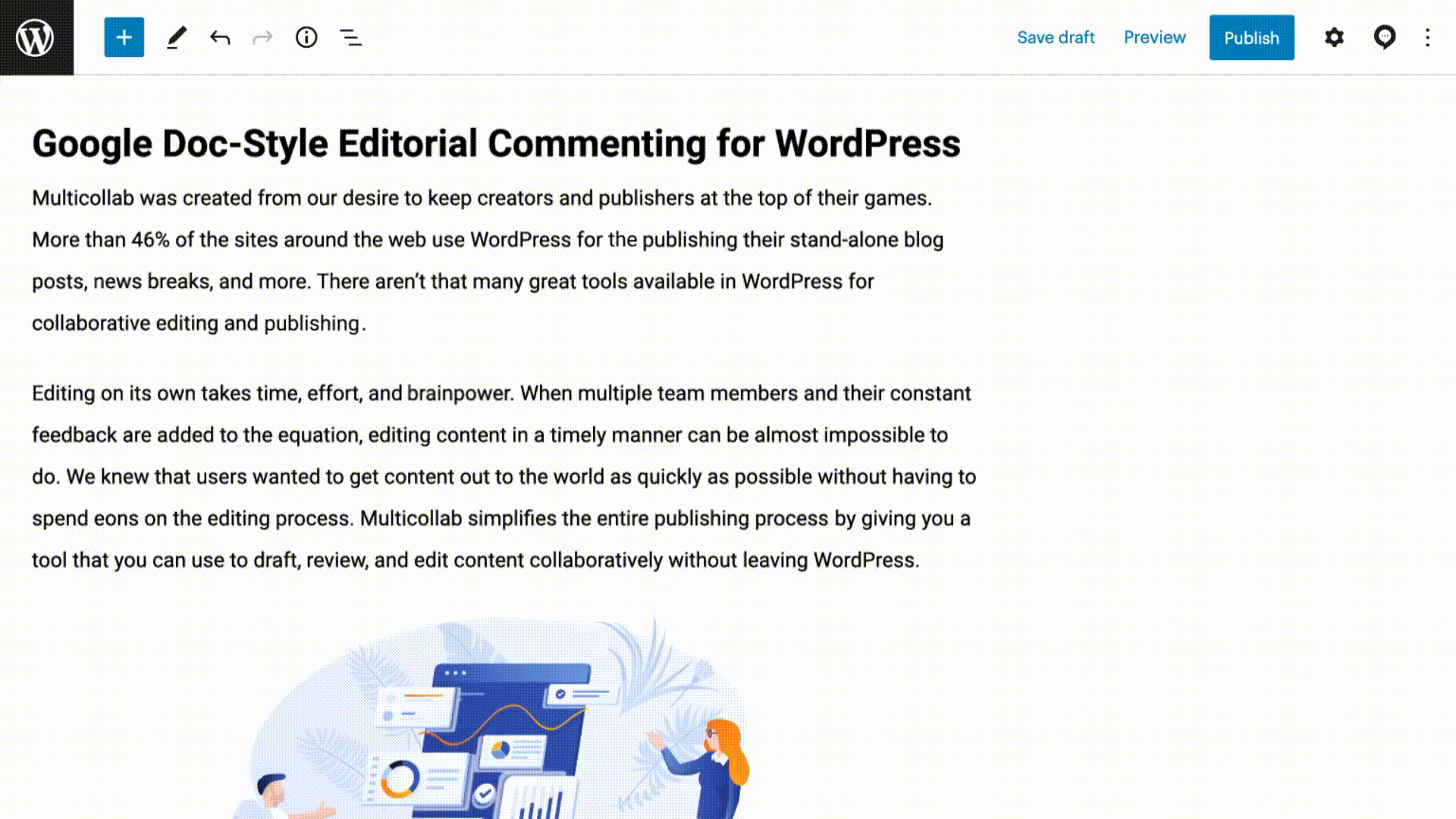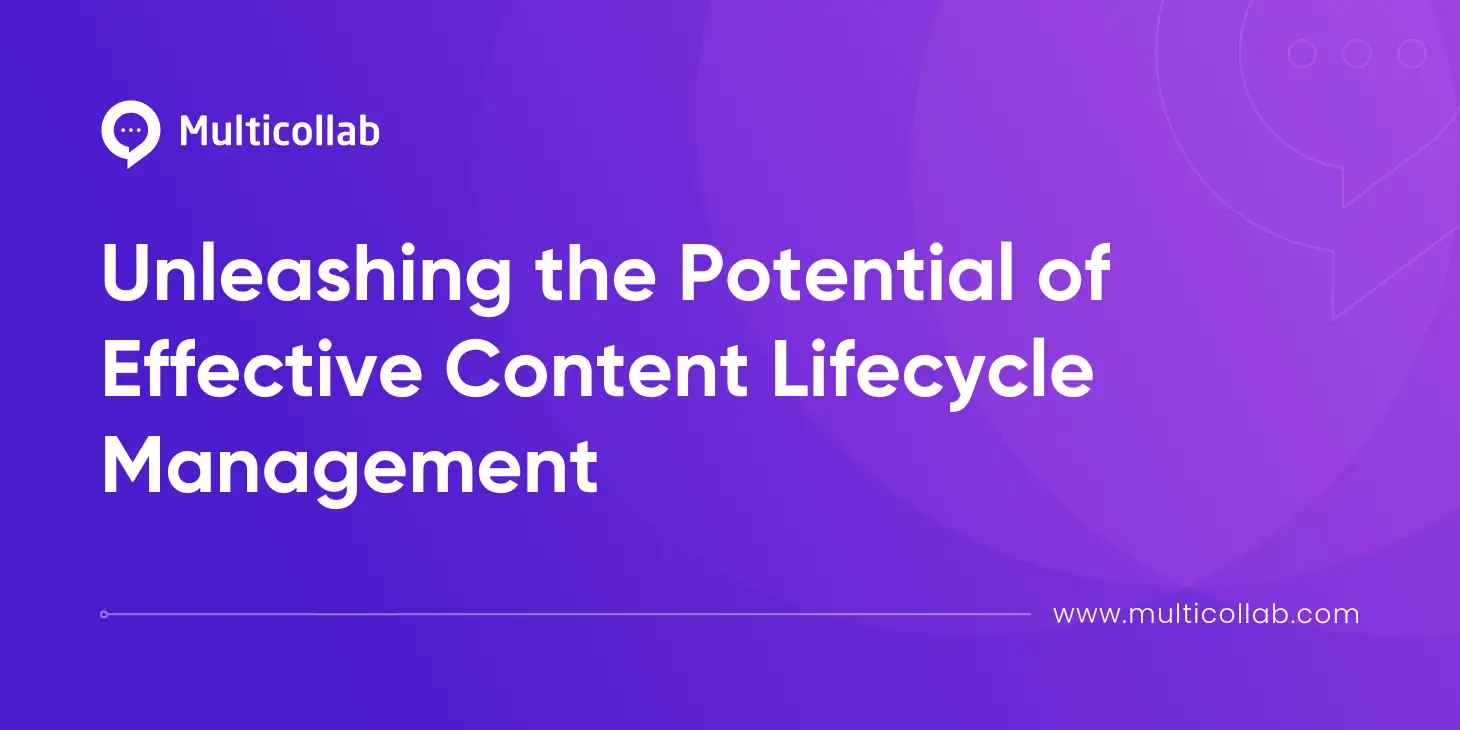Table of Contents
Managing content effectively is crucial for any digital strategy to succeed. Content lifecycle management plays a pivotal role in this process, serving as the backbone that guides the journey of digital assets from their inception to analysis and ongoing maintenance.
By adhering to this comprehensive strategy, businesses can maximize the value of their content and enhance their overall digital presence.
Yet, without proper practices and tools, navigating this journey can get difficult. Traditional challenges are still prevalent in remote teams, leading to inefficient workflows and communication breakdowns.
Let’s take a look at the essential stages of the digital content lifecycle, equipping you with best practices every step of the way. And, at the heart of it all lies Multicollab, our recommendation for elevating your content management game.
Key Stages of Content Lifecycle Management
Effective content lifecycle management is crucial for a successful content marketing strategy. It’s not just about creating content; it’s about having a seamless workflow right from conception to publication and beyond. Let’s take a look at the crucial stages that define this journey and explore how effective management at each step ensures success.
Planning
Before diving into content creation, it’s vital to take a step back and establish clear objectives that align with the broader business goals. This entails setting up key performance indicators (KPIs) and formulating SMART goals – ones that are Specific, Measurable, Achievable, Relevant, and Time-bound. By doing so, you not only provide direction for your content efforts but also ensure they contribute meaningfully to the overall success of your business strategy.
Additionally, teams should conduct thorough keyword and competitor research, review existing content to avoid duplicate content issues, and cluster topics to maximize subject matter authority. Don’t forget to outline realistic timelines and ensure all collaborators can fulfill their roles.
Creation
The creation phase marks the transformation of concepts and blueprints crafted during the planning stage into tangible content assets. It’s the crucible where ideas evolve into engaging narratives, informative articles, or captivating visuals.
Ensuring that every member of the content team is on the same page is essential for meeting the requirements outlined during the planning phase. From maintaining brand consistency to adhering to style guidelines and hitting key milestones, seamless collaboration is non-negotiable. Collaboration tools play a vital role in streamlining workflows and facilitating seamless coordination among team members. Platforms like Multicollab facilitate real-time communication, document sharing, and version control, fostering a cohesive workflow that transcends geographical boundaries. By harnessing the power of such tools, content creators can synergize their efforts, streamline processes, and elevate the quality of their output.
Review
The review phase of the content lifecycle serves as a pivotal checkpoint, where content undergoes thorough examination before its big reveal to the world. This stage is crucial for ensuring that the content adheres to brand standards, satisfies audience expectations, and aligns with strategic objectives.
Whether it’s input from subject matter experts, legal teams, or senior management, their feedback and approvals are instrumental in upholding the integrity and credibility of the content. Yet, the review phase isn’t without its hurdles. Lengthy feedback loops and complex approval procedures can hinder the timely release of content, resulting in missed chances and disgruntled stakeholders.
To mitigate these challenges, leveraging collaborative editing software can be a game-changer. Platforms like Multicollab enable both internal and external collaborators to work on content simultaneously in real time, fostering seamless collaboration and expediting the review process. By providing a centralized hub for feedback and revisions, such tools facilitate swift decision-making, ensuring that content meets deadlines without sacrificing quality.
Publication
As content creators, it’s easy to perceive the publication stage as the final lap of the race, a mere formality after the exhaustive rounds of review and editing. However, this phase holds its own set of critical considerations that can significantly impact the success of your content.
First and foremost, optimize your content for search engines by configuring SEO metadata, incorporating alt text for images, and implementing internal and external links. Implementing internal and external links further enriches the user experience while signaling credibility to search engine algorithms.
Yet, navigating the transition between your writing software and Content Management System (CMS) presents its own set of challenges. Ensuring formatting consistency, preserving hyperlinks, and seamlessly transferring content can be a daunting task, often leading to frustrating inconsistencies and delays.
Enter Multicollab – a game-changing solution that streamlines the publication process within WordPress. By enabling content writing, editing, and collaboration directly within the CMS, the plugin eliminates the need for cumbersome transitions, keeping everything seamlessly integrated into one cohesive platform. With Multicollab, content creators can bid farewell to the complexities of software compatibility, focusing instead on delivering content that captivates and resonates with audiences.
Promotion
Congratulations! Your content has successfully crossed the publication threshold, but the journey doesn’t end there. Now comes the crucial task of ensuring that your masterpiece reaches its intended audience and leaves a lasting impact.
Social media emerges as a powerhouse for your content amplification efforts. By strategically sharing your content across platforms like Facebook, Twitter, LinkedIn, and Instagram, you can tap into vast networks of potential readers and spark meaningful conversations around your brand. Email newsletters present another potent avenue for content promotion. Cultivating a loyal subscriber base and regularly sharing curated content directly in their inboxes fosters deeper engagement and cultivates brand loyalty over time.
Don’t overlook the power of partnerships and collaborations. Teaming up with influencers, industry experts, or complementary brands can exponentially expand your content’s reach, tapping into established audiences and driving traffic back to your digital hub. Additionally, consider repurposing your content into different formats to cater to diverse audience preferences. From podcasts and videos to infographics and webinars, exploring alternative mediums can breathe new life into your content and attract fresh eyes.
Analysis
Continuously examining your content’s performance is key to ensuring it stays aligned with the ever-changing needs and preferences of your audience. By diving into metrics and dissecting user behavior, you uncover invaluable insights into what resonates and what misses the mark.
Tools like Google Search Console become invaluable partners in this journey toward optimization. By monitoring content performance for specific target keywords, you gain visibility into how your content stacks up in the competitive realm of search engine results. Identifying top-performing pieces and discovering areas for enhancement empowers you to refine your content strategy and prioritize optimization efforts effectively.
Moreover, analysis isn’t just about evaluating past performance – it’s about guiding future action. Armed with actionable insights, you can implement targeted maintenance and optimization strategies to elevate underperforming content, capitalize on successful trends, and refine your overall content approach.
Maintenance
Keeping content relevant and effective requires ongoing maintenance. Informed by performance analysis, regular updates – whether small adjustments or significant revisions – are essential to ensure your content remains effective. Efficient version control is vital for smooth content updates, providing the ability to roll back changes if needed. By maintaining a clear record of revisions and iterations, you can confidently make changes, knowing you have the flexibility to revert to previous versions if necessary.
In some cases, retiring outdated or underperforming content might be the best course of action, freeing up resources for more impactful endeavors.
Mastering content lifecycle management not only boosts efficiency and revenue but also enhances the quality and impact of your content marketing efforts. By navigating each stage thoughtfully and leveraging tools like Multicollab, you can unleash the full potential of your content strategy.
Integrating Multicollab into Your Content Lifecycle
To truly excel in content lifecycle management, having the right tools at your fingertips is essential. Multicollab can be your ultimate partner in optimizing every aspect of your content journey. Let’s explore some of the key features that make Multicollab the perfect companion for streamlining your content lifecycle management.
Collaborative Editing: Bid farewell to lengthy feedback loops. With Multicollab, multiple collaborators can seamlessly work on the same content simultaneously, fostering efficient and collaborative content creation.
Slack and Email Notifications: Communication is key, even in asynchronous environments. Multicollab automatically notifies collaborators via Slack or email whenever new comments or suggestions are posted, ensuring timely feedback and streamlined communication.
Work Within WordPress: Say goodbye to platform-hopping headaches. Multicollab integrates seamlessly within WordPress, allowing every stage of the content lifecycle – from creation to review to publication – to occur within the familiar WordPress environment, minimizing inefficiencies and errors.
Manage Internal and External Collaborators: With Multicollab, you’re in control. Ensure that all stakeholders, whether internal or external, have the appropriate permissions to access and collaborate on content projects, facilitating smooth collaboration and workflow management.
Activity Log and Snapshot Reporting: Stay in the know with Multicollab’s comprehensive tracking features. The activity log and snapshot reporting functionalities keep you informed about all adjustments made to your content, enabling you to track revisions and monitor the impact of optimization work with ease.

Incorporating Multicollab into your content lifecycle empowers you to streamline processes, enhance collaboration, and maximize the effectiveness of your content strategy. With its robust features designed to address the challenges of content lifecycle management, Multicollab is the ultimate tool for driving content success.
Enhancing your content lifecycle process with Multicollab
Effective content lifecycle management remains pivotal in sustaining the success of your content strategy. By optimizing this process, you unlock various benefits, including enhanced efficiency in content creation, augmented revenue streams, and elevated content quality.
Yet, it’s not just about having the right process but also leveraging the appropriate tools. Multicollab emerges as the ideal solution for refining your content lifecycle management. With its robust collaboration features seamlessly integrated within WordPress, Multicollab eliminates the hassle of content transfers across platforms during production.
From streamlining workflows to fostering seamless collaboration among teams, Multicollab empowers you to elevate your content lifecycle management to new heights. Don’t let inefficiencies hinder your content success. Get Started with Multicollab to revolutionize your content lifecycle management today and unlock the full potential of your content strategy.






